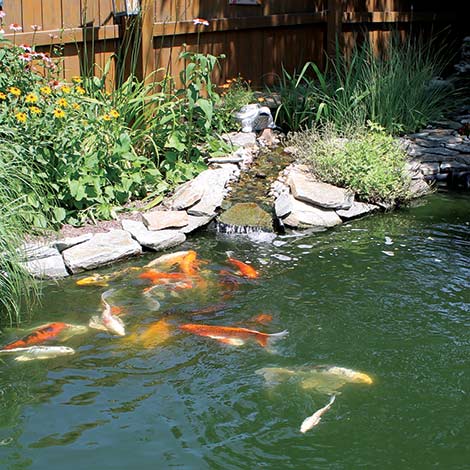Algae are a natural part of your water garden or pond, but large blooms can be quite a nuisance. Excessive algae growth can be caused by an overabundance of organics like fish waste, leaves, or previous algae blooms combined with sunlight.
While a little bit of algae is a sign of a healthy and functional aquatic ecosystem, some types of algae can be unsightly or downright harmful. Learn how to identify pond algae species in your water garden so you know when and how to treat them.
There are three basic types of pond algae: planktonic, filamentous, and Chara.
Planktonic Algae
Planktonic algae are floating microscopic organisms that cause pea soup coloring in shades of green, blue-green, ruddy-brown, and more. In controlled amounts, this type of algae in your water garden is the beneficial bottom of the pond food chain. Planktonic algae feeds fish and helps shade the pond's bottom, hindering weed growth. However, this algae can deplete the dissolved oxygen in the pond during uncontrolled blooms, leading to a fish kill.
Due to their microscopic size, it is almost impossible to accurately determine what type of algae is tinting your pond without lab tests. To get a close approximation, explore the following planktonic algae identification tips.
Green Algae: When your pond water resembles pea-soup, presenting a cloudy green color ranging from bright to olive, chances are you are dealing with standard green algae. As long as the population remains in check, this planktonic algae is an essential component of your pond and a sign of nutrient-rich conditions.
Brown and Red Algae: Ruddy pond water can often be attributed to Euglena algae blooms, which are common in nutrient-saturated ponds. These organisms can migrate downward into the water column to escape the hot afternoon sun, so you might see your pond change colors throughout the day.
Diatoms: Is your water garden a rich shade of golden yellow? You have a thriving population of “good algae” known as diatoms. They help control levels of other algae species while providing food for fish, controlling water pH, and filtering toxins. Due to their silica-based cell walls, diatoms are some of the most unique organisms on earth. They are commercially dried and pulverized into diatomaceous earth, which has many industrial and household applications.
Cyanobacteria: Despite the common name of blue-green algae, cyanobacteria are not actually algae but bacteria that thrive in freshwater ecosystems. If your water garden is a stunning shade of turquoise, lime-green, or red, with a putrid odor, you likely have cyanobacteria. Cyanobacterial blooms must be treated promptly due to the risk of harmful toxins that could threaten the lives of pets and cause illness in humans.
Filamentous Algae
Filamentous algae—known as string algae in ponds—are single-cell plants that form long, visible chains or threads. These threads start growing along the bottom of the pond in shallower water and intertwine to create mats that resemble wet wool. When the mats rise to the surface, they are referred to as pond scum. Scum mats are great homes for bugs and worms, but they can be unsightly and make swimming unpleasant.
Chara
Macroalgae are often mistaken for pond plants due to their complex structures with leaf- and stem-like features. They are typically found in the ocean, where you likely know them as seaweed or kelp. Chara is the most common type of macroalgae in freshwater ponds, and it includes stonewort, muskgrass, and sand grass. These algae form thick mats that stay submerged underwater, providing food for fish and waterfowl.
Tips for Controlling Different Types of Algae
Now, you should be able to more accurately identify the types of algae growing in your water garden. Are you ready to start controlling, preventing, and treating algae blooms? Explore the following related articles to learn helpful tips and advice for tackling pond algae.
Pond Algae Control: Remove & Prevent Blooms
Algae After Pond Cleanout
Fighting Green Water
Preventing String Algae in Winter
Last Updated: May 1, 2024



